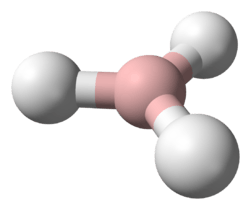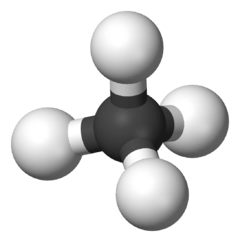Binary compounds of hydrogen
Binary compounds of hydrogen are binary chemical compounds containing just hydrogen and one other chemical element. By convention all binary hydrogen compounds are called hydrides even when the hydrogen atom in it is not an anion.[1][2][3][4] These hydrogen compounds can be grouped into several types.
Binary hydrogen compounds in group 1 are the ionic hydrides (also called saline hydrides) wherein hydrogen is bound electrostatically. Because hydrogen is located somewhat centrally in an electronegative sense, it is necessary for the counterion to be exceptionally electropositive for the hydride to possibly be accurately described as truly behaving ionic. Therefore, this category of hydrides contains only a few members.
Hydrides in group 2 are polymeric covalent hydrides. In these, hydrogen forms bridging covalent bonds, usually possessing mediocre degrees of ionic character, which make them difficult to be accurately described as either covalent or ionic. The one exception is beryllium hydride, which has definitively covalent properties.
Hydrides in the transition metals and lanthanides are also typically polymeric covalent hydrides. However, they usually possess only weak degrees of ionic character. Usually, these hydrides rapidly decompose into their component elements at ambient conditions. The results consist of metallic matrices with dissolved, often stoichiometric or near so, concentrations of hydrogen, ranging from negligible to substantial. Such a solid can be thought of as a solid solution and is alternately termed a metallic- or interstitial hydride. These decomposed solids are identifiable by their ability to conduct electricity and their magnetic properties (the presence of hydrogen is coupled with the delocalisation of the valence electrons of the metal), and their lowered density compared to the metal. Both the saline hydrides and the polymeric covalent hydrides typically react strongly with water and air.
It is possible to produce a metallic hydride without requiring decomposition as a necessary step. If a sample of bulk metal is subjected to any one of numerous hydrogen absorption techniques, the characteristics, such as luster and hardness of the metal is often retained to a large degree. Bulk actinoid hydrides are only known in this form. The affinity for hydrogen for most of the d-block elements are low. Therefore, elements in this block do not form hydrides (the hydride gap) under standard temperature and pressure with the notable exception of palladium.[5] Palladium can absorb up to 900 times its own volume of hydrogen and is therefore actively researched in the field hydrogen storage.
Elements in group 13 to 17 (p-block) form covalent hydrides (or nonmetal hydrides). In group 12 zinc hydride is a common chemical reagent but cadmium hydride and mercury hydride are very unstable and esoteric. In group 13 boron hydrides exist as a highly reactive monomer BH3, as an adduct for example ammonia borane or as dimeric diborane and as a whole group of BH cluster compounds. Alane (AlH3) is a polymer. Gallium exists as the dimer digallane. Indium hydride is only stable below −90 °C (−130 °F). Not much is known about the final group 13 hydride, thallium hydride.
Due to the total number of possible binary saturated compounds with carbon of the type CnH2n+2 being very large, there are many group 14 hydrides. Going down the group the number of binary silicon compounds (silanes) is small (straight or branched but rarely cyclic) for example disilane and trisilane. For germanium only 5 linear chain binary compounds are known as gases or volatile liquids. Examples are n-pentagermane, isopentagermane and neopentagermane. Of tin only the distannane is known. Plumbane is an unstable gas.
The hydrogen halides, hydrogen chalcogenides and pnictogen hydrides also form compounds with hydrogen, whose lightest members show many anomalous properties due to hydrogen bonding.
Non-classical hydrides are those in which extra hydrogen molecules are coordinated as a ligand on the central atoms. These are very unstable but some have been shown to exist.
The periodic table of the stable binary hydrides
The relative stability of binary hydrogen compounds and alloys at standard temperature and pressure can be inferred from their standard enthalpy of formation values.[6]
| H2 0 | He | ||||||||||||||||
| LiH -91 | BeH2 negative | BH3 41 | CH4 -74.8 | NH3 -46.8 | H2O -243 | HF -272 | Ne | ||||||||||
| NaH -57 | MgH2 -75 | AlH3 -46 | SiH4 31 | PH3 5.4 | H2S -20.7 | HCl -93 | Ar | ||||||||||
| KH -58 | CaH2 -174 | ScH2 | TiH2 | VH | CrH | Mn | Fe | Co | Ni | CuH | ZnH2 | GaH3 | GeH4 92 | AsH3 67 | H2Se 30 | HBr -36.5 | Kr |
| RbH -47 | SrH2 -177 | YH2 | ZrH2 | NbH | Mo | Tc | Ru | Rh | PdH | Ag | CdH2 | InH3 | SnH4 163 | SbH3 146 | H2Te 100 | HI 26.6 | Xe |
| CsH -50 | BaH2 -172 | HfH2 | TaH | W | Re | Os | Ir | Pt | Au | Hg | Tl | PbH4 252 | BiH3 247 | H2Po 167 | HAt positive | Rn | |
| Fr | Ra | Rf | Db | Sg | Bh | Hs | Mt | Ds | Rg | Cn | Nh | Fl | Mc | Lv | Ts | Og | |
| ↓ | |||||||||||||||||
| LaH2 | CeH2 | PrH2 | NdH2 | PmH2 | SmH2 | EuH2 | GdH2 | TbH2 | DyH2 | HoH2 | ErH2 | TmH2 | YbH2 | LuH2 | |||
| Ac | Th | Pa | U | Np | Pu | Am | Cm | Bk | Cf | Es | Fm | Md | No | Lr | |||
| Covalent hydrides | metallic hydrides |
| Ionic hydrides | Intermediate hydrides |
| Do not exist | Not assessed |
Molecular hydrides
Most monomeric hydrides are isolable only under extreme conditions (i.e. at cryogenic temperatures, and often embedded in a rare gas matrix). This is generally attributable to poor contribution of the atomic orbitals of the respective atoms with the s-orbital of hydrogen; and to the low activation enthalpies of autopolymerisation reactions, which electron-deficient monomers are prone to undergo. Relativistic effects interfere with the energy levels of molecular orbitals in the lowest periods of the periodic table. Hence, the degree of electron-deficiency of a monomer may be estimated incorrectly, if this is not taken into account. For example, based on it's position in the 12th column of the periodic table alone, mercury(II) hydride would be expected to be rather deficient. However, it is in fact satiated, being energetically more stable in monomeric form.
The table below shows the monomeric hydride for each element, which is closest to, but not surpassing its heuristic valence. A heuristic valence is the valence of an element that strictly obeys the octet, duodectet, and other valence rules. Elements may be prevented from reaching their heuristic valence for various electronic discrepancies. In chromium's case, stearic hindrance ensures that both the octahedral and trigonal prismatic molecular geometries for CrH
6 are metastable, with a very low energy barrier for conversion to a Kubas complex.
Where available, both the enthalpy of formation for each monomer and the enthalpy of formation for the hydride in its standard state is shown (in brackets) to give a rough indication of which monomers tend to undergo aggregation to lower enthalpic states. For example, monomeric lithium hydride has an enthalpy of formation of 139 kJ mol−1, whereas solid lithium hydride has an enthalpy of −91 kJ mol−1. This means that it is energetically favourable for a mole of monomeric LiH to aggregate into the ionic solid, losing 230 kJ as a consequence. Aggregation can occur as a chemical association, such as polymerisation, or it can occur as an electrostatic association, such as the formation of hydrogen-bonding in water.
Classical hydrides
| 1 | 2 | 3 | 4 | 5 | 6 | 5 | 4 | 3 | 2 | 1 | 2 | 3 | 4 | 3 | 2 | 1 | |
|---|---|---|---|---|---|---|---|---|---|---|---|---|---|---|---|---|---|
| H 2 0 | |||||||||||||||||
| LiH[7] 139 (−91) |
BeH 2[8] 123 |
BH 3[9] 107 (41) |
CH 4 −75 |
NH 3 −46 |
H 2O −242 (−286) |
HF −273 | |||||||||||
| NaH[10] 140 (−56) |
MgH 2 142 (−76) |
AlH 3[11] 123 (−46) |
SiH 4 34 |
PH 3 5 |
H 2S −21 |
HCl −92 | |||||||||||
| KH 132 (−58) |
CaH 2 192 (−174) |
ScH 3 |
TiH 4 |
VH 2[12] |
CrH 2[13] |
MnH 2[14] |
FeH 2[15] 324 |
CoH 2[16] |
NiH 2[17] |
CuH[18] 278 (28) |
ZnH 2[19] 162 |
GaH 3[20] 151 |
GeH 4 92 |
AsH 3 67 |
H 2Se 30 |
HBr −36 | |
| RbH 132 (−47) |
SrH 2 201 (−177) |
YH 3 |
ZrH 4 |
NbH 4[12] |
MoH 6[21] |
Tc | RuH 2[15] |
RhH 2[22] |
PdH[23] 361 | AgH[18] 288 | CdH 2[19] 183 |
InH 3[24] 222 |
SnH 4 163 |
SbH 3 146 |
H 2Te 100 |
HI 27 | |
| CsH 119 (−50) |
BaH 2 213 (−177) |
HfH 4 |
TaH 4[12] |
WH 6[25] 586 |
ReH 4[14] |
Os | Ir | PtH 2[26] |
AuH[18] 295 | HgH 2[27] 101 |
TlH 3[28] 293 |
PbH 4 252 |
BiH 3 247 |
H 2Po 167 |
HAt 88 | ||
| Fr | Ra | Rf | Db | Sg | Bh | Hs | Mt | Ds | Rg | Cn | Nh | Fl | Mc | Lv | Ts | ||
| ↓ | |||||||||||||||||
| 3 | 4 | 5 | 6 | 7 | 8 | 7 | 6 | 5 | 4 | 3 | 2 | 1 | 2 | 3 | |||
| LaH 3 |
CeH 4 |
PrH 3 |
NdH 4 |
Pm | SmH 4 |
EuH 3[29] |
GdH 3 |
TbH 3 |
DyH 4 |
HoH 3 |
ErH 2 |
TmH | YbH 2 |
LuH 3 | |||
| Ac | ThH 4[30] |
Pa | UH 4[31] |
Np | Pu | Am | Cm | Bk | Cf | Es | Fm | Md | No | Lr | |||
| Monomeric covalent hydride | 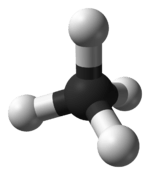 |
Oligomeric covalent hydride | 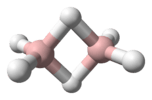 |
| Polymeric covalent hydride | 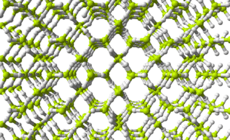 |
Ionic hydride | 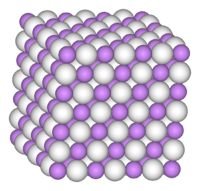 |
| Unknown solid structure |  |
Not assessed | |
This table includes the thermally unstable dihydrogen complexes for the sake of completeness. As with the above table, only the complexes with the most complete valence is shown, to the negligence of the most stable complex.
Non-classical covalent hydrides
A molecular hydride may be able to bind to hydrogen molecules acting as a ligand. The complexes are termed non-classical covalent hydrides. These complexes contain more hydrogen than the classical covalent hydrides, but are only stable at very low temperatures. They may be isolated in inert gas matrix, or as a crogenic gas. Others have only been predicted using computational chemistry.
| 8 | 18 | 8 | ||||||||||||
|---|---|---|---|---|---|---|---|---|---|---|---|---|---|---|
| LiH(H 2) 2[7] |
Be | BH 3(H 2) | ||||||||||||
| Na | MgH 2(H 2) n[32] |
AlH 3(H 2) | ||||||||||||
| K | Ca[33] | ScH 3(H 2) 6[34][35] |
TiH 2(H 2)[36] |
VH 2(H 2)[12] |
CrH2(H2)2 | Mn | FeH 2(H 2) 3[37] |
CoH(H 2) |
Ni(H 2) 4 |
CuH(H2) | ZnH 2(H 2) |
GaH 3(H 2) | ||
| Rb | Sr[33] | YH 2(H 2) 3 |
Zr | NbH 4(H 2) 4 |
Mo | Tc | RuH 2(H 2) 4[38] |
RhH3(H2) | Pd(H 2) 3 |
AgH(H2) | CdH(H 2) |
InH 3(H 2)[39] | ||
| Cs | Ba[33] | Hf | TaH 4(H 2) 4 |
WH 4(H 2) 4 |
Re | Os | Ir | PtH(H 2) |
AuH 3(H 2) |
Hg | Tl | |||
| Fr | Ra | Rf | Db | Sg | Bh | Hs | Mt | Ds | Rg | Cn | Nh | |||
| ↓ | ||||||||||||||
| 32 | 18 | |||||||||||||
| LaH 2(H 2) 2 |
CeH 2(H 2) |
PrH 2(H 2) 2 |
Nd | Pm | Sm | Eu | GdH 2(H 2) |
Tb | Dy | Ho | Er | Tm | Yb | Lu |
| Ac | ThH4(H2)4 | Pa | UH 4(H 2) 6[31] |
Np | Pu | Am | Cm | Bk | Cf | Es | Fm | Md | No | Lr |
| Assessed | Not assessed |
Hydrogen solutions
Hydrogen has a highly variable solubility in the elements. When the continuous phase of the solution is a metal, it is called a metallic hydride or interstitial hydride, on account of the position of the hydrogen within the crystal structure of the metal. In solution, hydrogen can occur in either the atomic or molecular form. For some elements, when hydrogen content exceeds its solubility, the excess precipitates out as a stoichiometric compound. The table below shows the solubility of hydrogen in each element as a molar ratio at 25 °C (77 °F) and 100 kPa.
| He | |||||||||||||||||
| LiH <1×10−4 [nb 1][40] |
Be | B | C | N | O | F | Ne | ||||||||||
| NaH <8×10−7 [nb 2][41] |
MgH <0.010 [nb 3][42] |
AlH <2.5×10−8 [nb 4][43] |
Si | P | S | Cl | Ar | ||||||||||
| KH <<0.01 [nb 5][44] |
CaH <<0.01 [nb 6][45] |
ScH ≥1.86 [nb 7][46] |
TiH 2.00 [nb 8][47] |
VH 1.00 [nb 9][48] |
Cr | MnH <5×10−6 [nb 10][49] |
FeH 3×10−8 [50] |
Co | NiH 3×10−5 [51] |
CuH <1×10−7 [nb 11][52] |
ZnH <3×10−7 [nb 12][53] |
Ga | Ge | As | Se | Br | Kr |
| RbH <<0.01 [nb 13][54] |
Sr | YH ≥2.85 [nb 14][55] |
ZrH ≥1.70 [nb 15][56] |
NbH 1.1 [nb 16][57] |
Mo | Tc | Ru | Rh | PdH 0.724 [58] |
AgH 3.84×10−14 [59] |
Cd | In | Sn | Sb | Te | I | Xe |
| CsH <<0.01 [nb 17][60] |
Ba | Hf | TaH 0.79 [nb 18][61] |
W | Re | Os | Ir | Pt | AuH 3.06×10−9 [58] |
HgH 5×10−7 [62] |
Tl | Pb | Bi | Po | At | Rn | |
| Fr | Ra | Rf | Db | Sg | Bh | Hs | Mt | Ds | Rg | Cn | Nh | Fl | Mc | Lv | Ts | Og | |
| ↓ | |||||||||||||||||
| LaH ≥2.03 [nb 19][63] |
CeH ≥2.5 [nb 20][64] |
Pr | Nd | Pm | SmH 3.00 [65] |
Eu | Gd | Tb | Dy | Ho | Er | Tm | Yb | Lu | |||
| Ac | Th | Pa | UH ≥3.00 [nb 21][66] |
Np | Pu | Am | Cm | Bk | Cf | Es | FM | Md | No | Lr | |||
| Miscible | Undetermined |
Notes
- ↑ Upper limit imposed by phase diagram, taken at 454 K.
- ↑ Upper limit imposed by phase diagram, taken at 383 K.
- ↑ Upper limit imposed by phase diagram, taken at 650 K and 25 MPa.
- ↑ Upper limit imposed by phase diagram, taken at 556 K.
- ↑ Upper limit imposed by phase diagram.
- ↑ Upper limit imposed by phase diagram, taken at 500 K.
- ↑ Lower limit imposed by phase diagram.
- ↑ Limit imposed by phase diagram.
- ↑ Limit imposed by phase diagram.
- ↑ Upper limit imposed by phase diagram, taken at 500 K.
- ↑ Upper limit imposed by phase diagram, taken at 1000 K.
- ↑ Upper limit at 500 K.
- ↑ Upper limit imposed by phase diagram.
- ↑ Lower limit imposed by phase diagram.
- ↑ Lower limit imposed by phase diagram.
- ↑ Limit imposed by phase diagram.
- ↑ Upper limit imposed by phase diagram.
- ↑ Limit imposed by phase diagram.
- ↑ Lower limit imposed by phase diagram.
- ↑ Lower limit imposed by phase diagram.
- ↑ Lower limit imposed by phase diagram.
References
- ↑ Concise Inorganic Chemistry J.D. Lee
- ↑ Main Group Chemistry, 2nd Edition A.G. Massey
- ↑ Advanced Inorganic Chemistry F. Albert Cotton, Geoffrey Wilkinson
- ↑ Inorganic chemistry, Catherine E. Housecroft,A. G. Sharpe
- ↑ Inorganic Chemistry Gary Wulfsberg 2000
- ↑ Data in KJ/mole gas-phase source: Modern Inorganic Chemistry W.L. Jolly
- 1 2 Wang, Xuefeng; Andrews, Lester (12 July 2007). "Infrared spectra and theoretical calculations of lithium hydride clusters in solid hydrogen, neon, and argon". The Journal of Physical Chemistry A. American Chemical Society. 111 (27): 6008–6019. doi:10.1021/jp071251y.
- ↑ Tague Jr., Thomas J.; Andrews, Lester (December 1993). "Reactions of beryllium atoms with hydrogen. Matrix infrared spectra of novel product molecules". Journal of the American Chemical Society (PDF). American Chemical Society. 115 (25): 12111–12116. doi:10.1021/ja00078a057.
- ↑ Tague Jr., Thomas J.; Andrews, Lester (June 1994). "Reactions of pulsed-laser evaporated boron atoms with hydrogen. Infrared spectra of boron hydride intermediate species in solid argon". Journal of the American Chemical Society. American Chemical Society. 116 (11): 4970–4976. doi:10.1021/ja00090a048. Retrieved 23 September 2013.
- ↑ Wang, Xuefeng; Andrews, Lester (2 August 2007). "Sodium hydride clusters in solid hydrogen and neon: infrared spectra and theoretical calculations". The Journal of Physical Chemistry A. American Chemical Society. 111 (30): 7098–7104. doi:10.1021/jp0727852.
- ↑ Chertihin, George V.; Andrews, Lester (October 1993). "Reactions of pulsed-laser ablated aluminum atoms with hydrogen: Infrared spectra of aluminum hydride (AlH, AlH2, AlH3, and Al2H2) species". The Journal of Physical Chemistry. American Chemical Society. 97 (40): 10295–10300. doi:10.1021/j100142a007. Retrieved 23 September 2013.
- 1 2 3 4 Wang, Xuefeng; Andrews, Lester (15 December 2011). "Tetrahydrometalate Species VH
2(H
2), NbH
4, and TaH
4: Matrix Infrared Spectra and Quantum Chemical Calculations". The Journal of Physical Chemistry A. ACS Publications. 115 (49): 14175–14183. doi:10.1021/jp2076148. - ↑ Wang, Xuefeng; Andrews, Lester (1 January 2003). "Chromium hydrides and dihydrogen complexes in solid neon, argon, and hydrogen: Matrix infrared spectra and quantum chemical calculations". The Journal of Physical Chemistry A. American Chemical Society. 107 (4): 570–578. doi:10.1021/jp026930h. Retrieved 30 September 2013.
- 1 2 Wang, Xuefeng; Andrews, Lester (30 April 2003). "Matrix infrared spectra and density functional theory calculations of manganese and rhenium hydrides". The Journal of Physical Chemistry A. American Chemical Society. 107 (20): 4081–4091. doi:10.1021/jp034392i. Retrieved 24 September 2013.
- 1 2 Wang, Xuefeng; Andrews, Lester (18 December 2008). "Infrared Spectra and Theoretical Calculations for Fe, Ru, and Os Metal Hydrides and Dihydrogen Complexes". The Journal of Physical Chemistry A. ACS Publications. 113 (3): 551–563. doi:10.1021/jp806845h.
- ↑ Billups, W. E.; Chang, Sou-Chan; Hauge, Robert H.; Margrave, John L. (February 1995). "Low-Temperature Reactions of Atomic Cobalt with CH
2N
2, CH
4, CH
3D, CH
2D
2, CHD
3, CD
4, H
2, D
2, and HD". Journal of the American Chemical Society. ACS Publications. 117 (4): 1387–1392. doi:10.1021/ja00109a024. - ↑ Li, S.; van Zee, R. J.; Weltner Jr., W.; Cory, M. G.; Zerner, M. C. (8 February 1997). "Magneto-Infrared Spectra of Matrix-Isolated NiH and NiH
2 Molecules and Theoretical Calculations of the Lowest Electronic States of NiH
2". The Journal of Chemical Physics. AIP Publishing. 106 (6): 2055–2059. doi:10.1063/1.473342. - 1 2 3 Wang, Xuefeng; Andrews, Lester (13 September 2003). "Infrared spectra and DFT calculations for the coinage metal hydrides MH, {{Chem|(H|2|)MH}}, MH
2, M
2H, M
2H−
, and (H
2)CuHCu in solid argon, neon, and hydrogen". The Journal of Physical Chemistry A. American Chemical Society. 107 (41): 8492–8505. doi:10.1021/jp0354346. Retrieved 24 September 2013. - 1 2 Greene, Tim M.; Brown, Wendy; Andrews, Lester; Downs, Anthony J.; Chertihin, George V.; Runeberg , Nino; Pyykko, Pekka (May 1995). "Matrix infrared spectroscopic and ab initio studies of ZnH2, CdH2, and related metal hydride species". The Journal of Physical Chemistry. American Chemical Society. 99 (20): 7925–7934. doi:10.1021/j100020a014. Retrieved 23 September 2013.
- ↑ Wang, Xuefeng; Andrews, Lester (2 December 2003). "Infrared spectra of gallium hydrides in solid hydrogen: {{Chem|Ga|H|1,2,3}}, Ga
2H
2,4,6, and the GaH−
2,4 anions". The Journal of Physical Chemistry A. American Chemical Society. 107 (51): 11371–11379. doi:10.1021/jp035393d. Retrieved 23 September 2013. - ↑ Wang, Xuefeng; Andrews, Lester (17 September 2005). "Matrix infrared spectra and density functional theory calculations of molybdenum hydrides". The Journal of Physical Chemistry A. American Chemical Society. 109 (40): 9021–9027. doi:10.1021/jp053591u. Retrieved 30 September 2013.
- ↑ Wang, Xuefeng; Andrews, Lester (19 March 2002). "Infrared spectra of rhodium hydrides in solid argon, neon, and deuterium with supporting density functional calculations". The Journal of Physical Chemistry A. American Chemical Society. 106 (15): 3706–3713. doi:10.1021/jp013624f. Retrieved 24 September 2013.
- ↑ Andrews, Lester; Wang, Xuefeng; Alikhani, Mohammad Esmaïl; Manceron, Laurent (6 March 2001). "Observed and calculated infrared spectra of {{Chem|Pd(H|2|)|1,2,3}} complexes and palladium hydrides in solid argon and neon". The Journal of Physical Chemistry A. American Chemical Society. 15 (13): 3052–3063. doi:10.1021/jp003721t. Retrieved 24 September 2013.
- ↑ Wang, Xuefeng; Andrews, Lester (24 April 2004). "Infrared spectra of indium hydrides in solid hydrogen and neon". The Journal of Physical Chemistry A. American Chemical Society. 108 (20): 4440–4448. doi:10.1021/jp037942l. Retrieved 23 September 2013.
- ↑ Wang, Xuefeng; Andrews, Lester (29 June 2002). "Neon Matrix Infrared Spectra and DFT Calculations of Tungsten Hydrides WH
x (x = 1−4, 6)". The Journal of Physical Chemistry A. ACS Publications. 106 (29): 6720–6729. doi:10.1021/jp025920d. - ↑ Andrews, Lester; Wang, Xeufeng; Manceron, Laurent (22 January 2001). "Infrared Spectra and Density Functional Calculations of Platinum Hydrides". The Journal of Chemical Physics. AIP Publishing. 114 (4): 1559. doi:10.1063/1.1333020.
- ↑ Wang, Xuefeng; Andrews, Lester (2 October 2004). "Solid Mercury Dihydride: Mercurophilic Bonding in Molecular HgH
2 Polymers". Inorganic Chemistry. ACS Publications. 43 (22): 7146–7150. doi:10.1021/ic049100m. - ↑ Wang, Xuefeng; Andrews, Lester (19 March 2004). "Infrared Spectra of Thallium Hydrides in Solid Neon, Hydrogen, and Argon". The Journal of Physical Chemistry A. ACS Publications. 108 (16): 3396–3402. doi:10.1021/jp0498973.
- ↑ Matsuoka, T.; Fujihisa, H.; Hirao, N.; Ohishi, Y.; Mitsui, T.; Masuda, R.; Seto, M.; Yoda, Y.; Shimizu, K.; Machida, A.; Aoki, K. (5 July 2011). "Structural and valence changes of europium hydride induced by application of high-pressure H
2". Physical Review Letters. 107 (2). Retrieved 19 November 2016. - ↑ Wang, Xuefeng; Andrews, Lester; Gagliardi, Laura (28 February 2008). "Infrared Spectra of ThH
2, ThH
4, and the Hydride Bridging ThH
4(H
2)
x (x = 1−4) Complexes in Solid Neon and Hydrogen". The Journal of Physical Chemistry A. ACS Publications. 112 (8): 1754–1761. doi:10.1021/jp710326k. - 1 2 Raab, Juraj; Lindh, Roland H.; Wang, Xuefeng; Andrews, Lester; Gagliardi, Laura (19 May 2007). "A Combined Experimental and Theoretical Study of Uranium Polyhydrides with New Evidence for the Large Complex UH
4(H
2)
6". The Journal of Physical Chemistry A. ACS Publications. 111 (28): 6383–6387. doi:10.1021/jp0713007. - ↑ Wang, Xuefeng; Lester Andrews (2004). "Infrared Spectra of Magnesium Hydride Molecules, Complexes, and Solid Magnesium Dihydride". The Journal of Physical Chemistry A. 108 (52): 11511–11520. doi:10.1021/jp046410h. ISSN 1089-5639.
- 1 2 3 Wang, Xuefeng; Andrews, Lester (December 2004). "Metal Dihydride (MH 2 ) and Dimer (M H2 ) Structures in Solid Argon, Neon, and Hydrogen (M = Ca, Sr, and Ba): Infrared Spectra and Theoretical Calculations". The Journal of Physical Chemistry A. 108 (52): 11500–11510. doi:10.1021/jp046046m.
- ↑ Zhao, Yufeng; Kim, Yong-Hyun; Dillon, Anne C.; Heben, Michael J.; Zhang, Shengbai (4 August 2014). "Towards High wt%, Room Temperature Reversible, Carbon-Based Hydrogen Adsorbents". ResearchGate. Retrieved 30 November 2015. Scandium has many empty orbitals to accommodate dihydrogen
- ↑ Zhao, Yufeng; Kim, Yong-Hyun; Dillon, A. C.; Heben, M. J.; Zhang, S. B. (22 April 2005). "Hydrogen Storage in Novel Organometallic Buckyballs". Physical Review Letters. 94 (15). Bibcode:2005PhRvL..94o5504Z. doi:10.1103/PhysRevLett.94.155504.
- ↑ Ma, Buyong; Collins, Charlene L.; Schaefer, Henry F. (January 1996). "Periodic Trends for Transition Metal Dihydrides MH , Dihydride Dihydrogen Complexes MH 2 ·H2 , and Tetrahydrides MH4 (M = Ti, V, and Cr)". Journal of the American Chemical Society. 118 (4): 870–879. doi:10.1021/ja951376t.
- ↑ Wang, Xuefeng; Andrews, Lester (18 December 2008). "Infrared spectra and theoretical calculations for Fe, Ru, and Os metal hydrides and dihydrogen complexes". The Journal of Physical Chemistry A. American Chemical Society. 113 (3): 551–563. doi:10.1021/jp806845h. Retrieved 24 September 2013.
- ↑ Wang, Xuefeng; Andrews, Lester (13 August 2008). "Infrared spectrum of the RuH
2(H
2)
4 complex in solid hydrogen". Organometallics. American Chemical Society. 27 (17): 4273–4276. doi:10.1021/om800507u. - ↑ Wang, Xuefeng; Andrews, Lester (May 2004). "Infrared Spectra of Indium Hydrides in Solid Hydrogen and Neon". The Journal of Physical Chemistry A. 108 (20): 4440–4448. doi:10.1021/jp037942l.
- ↑ Songster, J.; Pélton, A. D. (1 June 1993). "The H-Li (Hydrogen-Lithium) System". Journal of Phase Equilibria. Springer-Verlag. 14 (3): 373–381. doi:10.1007/BF02668238.
- ↑ San-Martin, A.; Manchester, F. D. (1 June 1990). "The H-Na (Hydrogen-Sodium) System". Bulletin of Alloy Phase Diagrams. Springer US. 11 (3): 287–294. doi:10.1007/BF03029300.
- ↑ San-Martin, A.; Manchester, F. D. (1 October 1987). "The H−Mg (Hydrogen-Magnesium) System". Journal of Phase Equilibria. Springer-Verlag. 8 (5): 431–437. doi:10.1007/BF02893152.
- ↑ Qiu, Caian; Olson, Gregory B.; Opalka, Susanne M.; Anton, Donald L. (1 November 2004). "Thermodynamic evaluation of the Al-H system". Journal of Phase Equilibria and Diffusion. Springer-Verlag. 25 (6): 520–527. doi:10.1007/s11669-004-0065-1. ISSN 1863-7345.
- ↑ Sangster, J.; Pelton, A. D. (1 August 1997). "The H-K (Hydrogen-Potassium) System". Journal of Phase Equilibria. Springer-Verlag. 18 (4): 387–389. doi:10.1007/s11669-997-0066-y.
- ↑ Predel, B. (1993). "Ca-H (Calcium-Hydrogen)". In Madelung, O. Ca-Cd – Co-Zr. Springer Berlin Heidelberg. pp. 1–3. ISBN 978-3-540-47411-1.
- ↑ Manchester, F. D.; Pitre, J. M. (1 April 1997). "The H-Sc (Hydrogen-Scandium) System". Journal of Phase Equilibria. Springer-Verlag. 18 (2): 194–205. doi:10.1007/BF02665706.
- ↑ San-Martin, A.; Manchester, F. D. (1 February 1987). "The H−Ti (Hydrogen-Titanium) System". Bulletin of Alloy Phase Diagrams. Springer US. 8 (1): 30–42. doi:10.1007/BF02868888.
- ↑ Predel, B. (1996). "H-V (Hydrogen-Vanadium)". In Madelung, O. Ga-Gd – Hf-Zr. Springer Berlin Heidelberg. pp. 1–5. ISBN 978-3-540-44996-6.
- ↑ San-Martin, A.; Manchester, F. D. (1 June 1995). "The H-Mn (Hydrogen-Manganese) System". Journal of Phase Equilibria. Springer-Verlag. 16 (3): 255–262. doi:10.1007/BF02667311.
- ↑ San-Martin, A.; Manchester, F. D. (1 April 1990). "The Fe-H (Iron-Hydrogen) System". Bulletin of Alloy Phase Diagrams. Springer-Verlag. 11 (2): 173–184. doi:10.1007/BF02841704.
- ↑ Wayman, M. L.; Weatherly, G. C. (1 October 1989). "The H−Ni (Hydrogen-Nickel) System". Bulletin of Alloy Phase Diagrams. Springer US. 10 (5): 569–580. doi:10.1007/BF02882416.
- ↑ Predel, B. (1994). "Cu-H (Copper-Hydrogen)". In Madelung, O. Cr-Cs – Cu-Zr. Springer Berlin Heidelberg. pp. 1–3. ISBN 978-3-540-47417-3.
- ↑ San-Martin, A.; Manchester, F. D. (1 December 1989). "The H-Zn (Hydrogen-Zinc) System". Bulletin of Alloy Phase Diagrams. Springer US. 10 (6): 664–666. doi:10.1007/BF02877640.
- ↑ Sangster, J.; Pelton, A. D. (1 February 1994). "The H-Rb (Hydrogen-Rubidium) System". Journal of Phase Equilibria. Springer-Verlag. 15 (1): 87–89. doi:10.1007/BF02667687.
- ↑ Khatamian, D.; Manchester, F. D. (1 June 1988). "The H−Y (Hydrogen-Yttrium) System". Bulletin of Alloy Phase Diagrams. Springer US. 9 (3): 252–260. doi:10.1007/BF02881276.
- ↑ Zuzek, E.; Abriata, J. P.; San-Martin, A.; Manchester, F. D. (1 August 1990). "The H-Zr (Hydrogen-Zirconium) System". Bulletin of Alloy Phase Diagrams. Springer-Verlag. 11 (4): 385–395. doi:10.1007/BF02843318.
- ↑ Okamoto, H. (1 April 2013). "H-Nb (Hydrogen-Niobium)". Journal of Phase Equilibria and Diffusion. Springer US. 34 (2): 163–164. doi:10.1007/s11669-012-0165-2.
- 1 2 Materials Science International Team (2006). "Au-H-Pd (Gold - Hydrogen - Palladium)". In Effenberg, G.; Ilyenko, S. Noble Metal Systems. Selected Systems from Ag-Al-Zn to Rh-Ru-Sc. Berlin: Springer Berlin Heidelberg. pp. 1–8. ISBN 978-3-540-46994-0.
- ↑ Subramanian, P.R (1 December 1991). "The Ag-H (Silver-Hydrogen) System". Journal of Phase Equilibria. Springer-Verlag. 12 (6): 649–651. doi:10.1007/BF02645164.
- ↑ Songster, J.; Pelton, A. D. (1 February 1994). "The H-Cs (Hydrogen-Cesium) System". Journal of Phase Equilibria. Springer-Verlag. 15 (1): 84–86. doi:10.1007/BF02667686.
- ↑ San-Martin, A.; Manchester, F. D. (1 June 1991). "The H-Ta (Hydrogen-Tantalum) System". Journal of Phase Equilibria. Springer-Verlag. 12 (3): 332–343. doi:10.1007/BF02649922.
- ↑ Guminski, C. (1 October 2002). "The H-Hg (Hydrogen-Mercury) System". Journal of Phase Equilibria. Springer-Verlag. 23 (5): 448–450. doi:10.1361/105497102770331460.
- ↑ Khatamian, D.; Manchester, F. D. (1 February 1990). "The H-La (Hydrogen-Lanthanum) System". Bulletin of Alloy Phase Diagrams. Springer-Verlag. 11 (1): 90–99. doi:10.1007/BF02841589.
- ↑ Manchester, F. D.; Pitre, J. M. (1 February 1997). "The Ce-H (Cerium-Hydrogen) system". Journal of Phase Equilibria. Springer-Verlag. 18 (1): 63–77. doi:10.1007/BF02646759.
- ↑ Zinkevich, M.; Mattern, N.; Handstein, A.; Gutfleisch, O. (13 June 2002). "Thermodynamics of Fe–Sm, Fe–H, and H–Sm Systems and its Application to the Hydrogen–Disproportionation–Desorption–Recombination (HDDR) Process for the System Fe
17Sm
2–H
2". Journal of Alloys and Compounds. Elsevier. 339 (1-2): 118–139. doi:10.1016/S0925-8388(01)01990-9. - ↑ Manchester, F. D.; San-Martin, A. (1 June 1995). "The H-U (Hydrogen-Uranium) System". Journal of Phase Equilibria. Springer-Verlag. 16 (3): 263–275. doi:10.1007/BF02667312.
